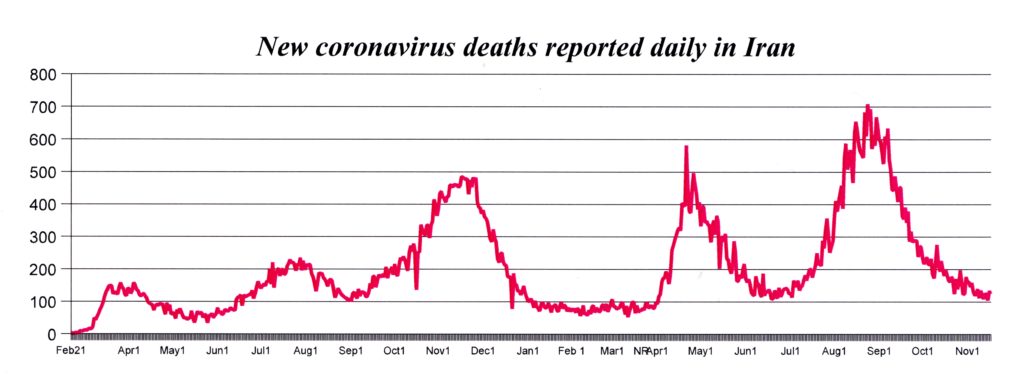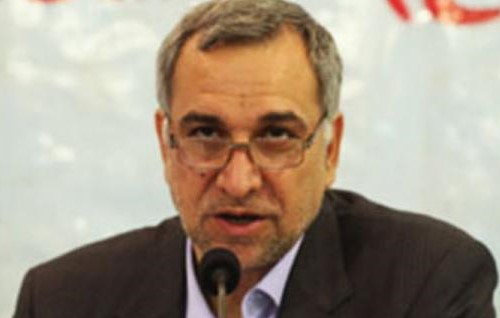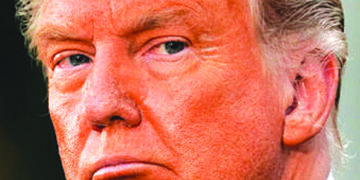November 19, 2021
New statistics suggest that many of the vaccines Iran has used are not very effective as many citizens are getting the disease a second time.

 Some provinces have reported more cases of the coronavirus than they have residents. That would indicate that some residents are getting the disease for the second time. And that suggests that some of the vaccines being administered are not efficacious that is, that they are not doing their job of protecting people from the disease.
Some provinces have reported more cases of the coronavirus than they have residents. That would indicate that some residents are getting the disease for the second time. And that suggests that some of the vaccines being administered are not efficacious that is, that they are not doing their job of protecting people from the disease.

The Islamic Republic has not produced province-by-province coronavirus data. But Mahan Ghafari of the University of Oxford and some of his colleagues say they have received the localized data and they show that by mid-September a total of 11 of Iran’s 31 provinces were reporting infection rates near to or higher than 100 percent.
Ghaffari told US National Public Radio, “In a particular province Sistan va Baluch-estan we found 254 percent of the people exposed. That means even more than twice being exposed to the disease over a period of 19 months.”
As of mid-November, 50 percent of the Iranian population is fully vaccinated, compared to 58 percent in the United States, 88 percent in the UAE and a standard-setting 92 percent in Singapore.
But Iran is not using many vaccines with a proven record. The main vaccine used in Iran is China’s Sinopharm, which accounts for 88 percent of all vaccine imports. Russia’s Sputnik V accounts for 4 percent.
The problem is, the Russian Sputnik V vaccine hasn’t been thoroughly tested. And the Chinese Sinovac is probably less effective than the leading Western vaccines. The Iranian government is also developing its own vaccines, but recently abandoned one of them owing to a lack of orders. “The government’s response has been a disaster,” Hadi Ghaemi, executive director of the New York-based Center for Human Rights in Iran, told The Daily Beast.
Iran’s Food & Drug Agency finally gave approval October 31 for use of two domestically-made vaccines Razi COV-Pars and Fakhra after they completed the third phase of human trials. Before that, only the COV-Iran Barekat vaccine, approved in June, was being used.
However, one month earlier, the Defense Ministry said it was stopping production of Fakhra because it hadn’t received enough money from the government for research and because it could not find enough volunteers for the third phase of human testing. The discrepancy in statements was not explained.
Furthermore, Mohammad-Reza Mahboubfar, a health expert writing in the daily Hamdeli October 13, reported that the use of COV-Iran Barekat had been suspended because of complaints of painful side effects and reports that many who had received the shot had later gotten sick from the coronavirus. The government did not confirm that report, however, nor did the Iran Times see it reported anywhere else.
The Raisi government is continuing to emphasize the use of foreign vaccines, a shift made in the closing days of the Rohani Administration.
The official statistics show that the volume of the cases and deaths are way down in Iran. While no one believes the numbers include all the cases and deaths in no country are the data complete the statistics are believed to show whether the disease is ramping up or slowing down. And they show it is slowing down. However, new Health Minister Bahram Eyenollahi warns almost daily that he expects the disease to begin ramping up soon and predicts Iran will experience a sixth peak.
Nonetheless, society is returning rapidly to normal. This is not unique to Iran. In most countries, a public wearied by 20 months of living behind a mask is demanding a return to normality. But the statistics published by the government are all positive. The number of new cases reported daily has been below 10,000 since the first week of November. The number of daily deaths has been below 200 since mid-October. The number of cities in the “red” category, indicating the disease is raging, is down to just 33, with 95 in the next category, orange, 220 in the yellow category and 100 rated “blue,” meaning the disease is under control there.
But the government is trying to enforce some restrictions. Since November 22, no one lacking proof of vaccination or a recent negative covid test is allowed to board a plane, ship, train or intercity bus. Travelers are required to have received two doses or one dose less than month before traveling.
Airlines are now allowed to fill 100 percent of their seats, up from 60 percent previously. Trains, ships and buses can use 80 percent of their seats.
As of October 23, the government said government agencies should not allow any staff into the office unless they had received at least one shot and from October 24 only shops whose employees had received at least one dose were allowed to stay open. But few believed those rules were enforceable, given the ease with which fake vaccination certificates could be obtained.
The government has opened the country to foreign tourists and the first batch of tourists, from Russia, arrived early in November, followed a few days later by nine French tourists.















